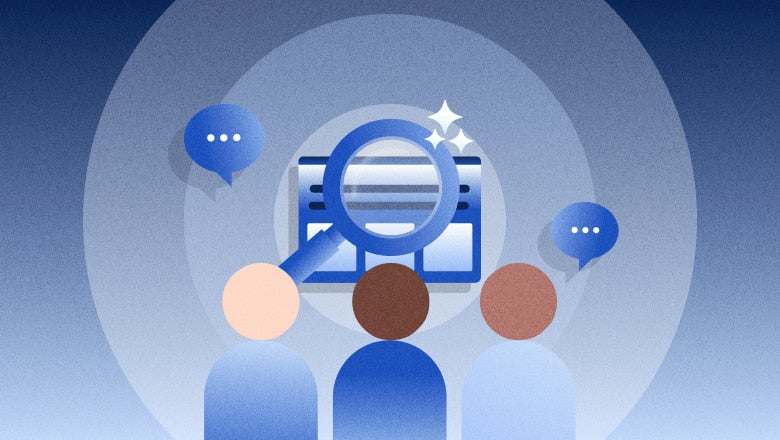How to use social listening tools to build a stronger business

Table of Contents
Effective communication relies on good listening. It’s the first step to understanding other people—whether in a tense boardroom negotiation or a casual meeting with friends.
The same applies to listening to your brand’s audience. In today’s marketing landscape especially, social listening is vital for successful brand communication.
Social media is the world’s largest and most transparent focus group. And social listening enables you to tap into that focus group, their conversations and the trends happening not just around your brand, but around your whole industry.
Many marketers already have access to social listening tools that help them hone into these important conversations. However, they aren’t using them to their best advantage.
In this article, we explain why a listening strategy is so important, how listening insights can improve your business, and how to use Sprout Social for social listening. You’ll also see the different ways we use Sprout Social Listening to translate customer needs into strategic action.
For a quick overview, you can watch this video to get a high-level preview of social media listening use cases, actionable tactics and 5 questions you can answer with your own brand’s listening strategy.
What you need to know before creating a social listening strategy
Social listening is the process of figuring out what’s being said about your brand, products or business through social channels.
It can be seen as an evolution of social monitoring; where social monitoring can tell you what conversations are happening, social listening tells you why.

Collecting this level of insight is possible thanks to social listening tools. But before you create your own listening strategy, there are a few key points you need to consider.
Listening strategies should align with business goals
Social media platforms are crowded, noisy places. Trying to listen to everything posted on multiple platforms at once is a recipe for overwhelm.
The biggest trap marketers can fall into with social listening is simply not knowing what to focus on.
When defining your listening strategy, you first need to make sure your listening focus aligns with your company’s goals.
The best way to do this is to create specific social listening queries. These queries are strict search parameters that you use as search functions in a social listening tool.

Query examples might include keywords, phrases, emojis, hashtags and cashtags, among other data points.
If you’re just getting started with social listening, it’s wise to focus on keywords based on your main goals. For example, your goal might be to reduce the levels of customer churn for your latest software subscription.
In this case, your query could be made up of keywords related to this specific subscription and customer experience. If you combine these with common phrases meant to praise or criticize, you’ll gain a clearer picture of customer opinions surrounding the subscription.
You can then use the listening data to target the biggest issues, reducing churn in the future.
Another example might be to listen to comments on your competitor’s social posts. This shows how positively their products are being received, and can give you insight into changes you could make in the future. Competitor listening insights can also direct your future content strategies.

But these are just a couple of use cases. Make sure to clearly define your business goals, then consider how social listening can help uncover the social audience insights you need to achieve them.
Listening topics are informed by native research
Social listening is most effective when you know exactly what you’re listening for.
In addition to your business goals, social listening topics can also reveal themselves through native research.
Instead of expecting to find trends solely through social listening, consider finding trends through your native research campaigns. This could be done by manually reviewing the native analytics of your social platforms, analyzing comprehensive network reports from a tool like Sprout, or through recent company reports like market research or competitive intel.

In these instances, social listening can be a vital supplement to your initial research.
For example, a recent piece of market research might suggest customers prefer live chat responses over phone calls when they experience a problem.
You can then use social listening to find conversations surrounding problems with your service across forums such as Reddit. Listening enables you to see how problems were resolved while gathering insights on how positively or negatively the user found their experience.
Targeted social listening like this will support prior market research, and give you actionable insights to improve your customer support process.
Remember that social listening is a powerful tool, but it’s at its strongest when combined with other research and strategies.
Listening queries require ongoing refinement
Just like in real life, conversations across social platforms change over time. If you’ve found a successful query one moment, there’s no guarantee it’ll be as effective when you try it again next month.
To avoid this, you need to factor query refinement into your process.

Continue to stay tapped into social channels and assess how conversations have evolved. You can then apply these changes to your social listening queries, so your tools give you more accurate insights.
It’s also important to refine your queries regularly so you’re always in tune with changing customer needs and wants. A reliable way to do this is by setting a monthly reminder in your marketing calendar.
Though they’re powered by strong conversational analytics, social listening tools are only as effective as the direction you give them. If you see listening as an ever-changing process, you’ll get better at creating queries yourself and get better results from your tool.
How Sprout Social uses social listening across the business
According to The 2025 Impact of Social Media Report, business leaders want teams like customer experience and success, customer care and support, and business development to be driven by social insights.
At Sprout, we’re already doing this. We use social listening to generate insights that feed into a company-wide strategy to inform business decisions, drive innovation and strengthen customer relationships. It goes far beyond just marketing.
“We see so many use cases and ways that listening changes the game for how social gets a seat at the table for organizations. Social now goes beyond marketing and into insights that change how businesses act,” Steph Hermanson, Manager, Professional Services at Sprout Social, explains.
Social listening enables us to turn real-time conversations into actionable insights so that every team across Sprout is connected to what our audiences need and expect. This holistic approach fuels smarter business outcomes and deeper customer connections.
Here’s a deeper look at how social listening informs our various departments. It’ll also inspire you on how to use Sprout Social for social listening in your own business environment.
Marketing
A core part of a company’s marketing strategy are the landing pages that live on its product website. Unlike general site pages, landing pages are designed to support campaigns, capture leads and convert visitors into customers. Often serving as the destination for paid ads and social media outreach, the goal of the landing page is to optimize performance, measure engagement and ultimately generate demand.
Given how crucial landing pages are to marketing efforts, we used Sprout Social Listening to create trending landing pages—from the Oscars to Coachella—for Listening and influencer marketing. Built on a tiered approach to support large-scale events and industry-specific events, these pages enable us to tap into the top trends across global events with relevant content.
In addition to the Listening Landing Pages, the team also built a marketing trends page that’s evergreen and captures what’s top-of-mind for audiences. This enables the Sprout team to talk to brands across industries and join conversations with our audiences as they’re happening. The page captures the most innovative brands in marketing and shares the top creators and influencers.

“We’re creating these Listening and Influencer Marketing landing pages to show how brands can tap into cultural moments—like Coachella, the Oscars, the Super Bowl, and more—to stay ahead of trends, join real-time conversations, and build stronger connections with their audiences,” Olivia Jepson, Social Media Intelligence Manager, says.
Having driven a 77% increase in awareness year-over-year from trendspotting social content, these landing pages also serve to highlight our social intelligence tools. Plus, the insights from conversations and feedback are crucial for our sales and success teams.
“Through close collaboration with Sales and Success, and by consistently sharing product feedback, we’re creating value for every social team and using these insights to shape and improve our products for our customers,” Jespson adds.
Industry insights
The Professional Services team at Sprout plays a critical role in helping clients optimize the value of the Sprout Social platform through personalized onboarding, technical implementation, strategic insights and education. Their efforts ensure all customers—from growing businesses to enterprises—realize measurable success with Sprout’s tools. And social listening is a cornerstone of how Premier Success, Sprout’s Professional Services team, supports customers.
“How we work in Services is directly in the trenches with our customers and provide strategic guidance. We do focus projects around listening audits, discovery and strategic planning, listening optimization, query research and building, theme identification, data analysis and reporting, and everything in between,” Hermanson says.
The team comprises not just product experts but also people who know how powerful social listening can be for any industry. And that’s how they’re able to guide Sprout customers through listening for all use cases and industries. This includes marketing, customer care and R&D.
“We see it (social listening) for agencies, entertainment, food & bev, healthcare, education, government & public sector, nonprofit, retail & CPG, travel & tourism and literally every other space,” Hermanson adds.
Here are a few industry examples of how our Professional Service team uses listening to provide insights and guidance to Sprout customers in various industries:
Healthcare
A healthcare technology company has announced a new insulin pump that was years in the making. They needed a way to track conversations after their announcement to answer questions for product marketing, product development and engineering teams alongside senior leaders. The Sprout team was able to work alongside the customer to create a feedback loop through both earned and owned mentions.
We set up a topic in Social Listening and Tagging in the Smart Inbox to understand the product launch feedback. The customer now had more data than ever with a new product launch. The listening insights enabled them to inform additional product enhancements and combat misinformation in the market to protect brand reputation.
Transportation
A state department of transportation wanted to be ready for any situation during inclement weather to ensure the safety of residents and commuters. The department considers social as the first line of defense in keeping the community safe. However, their marketing team didn’t have a way to alert safety divisions about downed trees, power lines and vehicle crashes that were being shared on social media.
Sprout’s Professional Services team created Listening Topics with spike alerts to inform all critical response teams about safety risks on the roads related to inclement weather. We also provided insights on the words, emojis and hashtags being used in the region colloquially to ensure all data was captured.
With these trackers in place, the customer was able to get critical data and share it with multiple divisions to keep people informed and the public safe through quick action.
Restaurant
A restaurant chain customer wanted to identify popular sushi spots and other successful restaurants in a new city to guide their menu research and shape concept development. The Sprout team created custom topics that captured mentions of restaurants and sushi restaurants in conjunction with the city of interest. The team also created a report that highlighted top restaurant mentions, specific dishes and other relevant information.
The data from Social Listening and the analysis from the Professional Services team provided the customer’s R&D team with critical information to influence menu items and the location of the new restaurant. The insights also supported positioning their unique value in the new city.
Media and entertainment
The customer is a podcast producer and wanted to better understand where listeners were consuming podcasts. Using Sprout Social Listening, the Professional Services team built an industry trends topic to find podcast listeners. They then created themes for the common ways that people listen, such as when working out, commuting or doing household chores.
The Sprout team also used the conversation cloud to explore other unique ways people listen to podcasts, to find trending topics to share on social and to find new advocates for the brand. This industry and user data informed the customer’s marketing teams not only for the current podcast but also on how to build more effective campaigns across multi-media in the future as they launched new shows.
PR & reputation management
Social listening enables PR teams to share stories with journalists and media outlets that highlight the brand’s news, initiatives and thought leadership. Through press releases, pitches and strategic outreach, PR works to secure coverage that boosts credibility and visibility. Listening also helps keep a tab on reputation building and management.
Sprout’s PR team uses Sprout Listening for all these purposes and more. They also tapped into our trending Landing Pages built through social listening to secure media coverage by connecting Sprout data with the big stories dominating headlines.
“This approach highlights the real power of social listening as it gives media, brands and audiences fresh perspectives on how people are experiencing current and popular events,” says Abigail Hart, Media Relations Manager at Sprout Social.
According to Hart, social listening is important to media and journalism. It gives reporters access to candid, unedited audience conversations and reactions, which in turn reveal the true, unedited narrative that helps uncover the authentic story behind public sentiment and trends.
“Reporters turn to listening data because it surfaces unique insights, from public sentiment to trending moments to the brands that are winning attention in real time. By putting social conversations at the center, we’re able to fuel richer, more human stories that resonate far beyond the news cycle,” she says.
In the same vein, managing brand reputation is a key example of how to use Sprout Social for social listening. What makes this so impactful is that social listening goes beyond surface-level coverage to show the why behind audience reactions. It captures not just what happened, but how people felt about it, what they chose to share and the narratives that gained traction organically.
“This opportunity isn’t unique to Sprout,” Hart says. “Any brand can use listening data to sharpen its storytelling because social listening offers a window into the conversations that matter most—in real time,” she notes.
How to use social listening to uncover actionable insights
With the above factors in mind, here’s how to start using your social listening tools more effectively with these five steps.
1. Define your “why”
Determine why you’re using social listening in the first place. Doing this at the beginning of your strategy means you’re always listening for the right data points.
Defining listening goals will look different for every organization. Some initial questions relevant in most situations include:
- What data is important for our business goals?
- Who needs this information internally?
- What problem are we trying to solve through social listening?
Make this process easier with Sprout’s social listening strategy template. This template enables you to align your goals with customer experience and set up your social listening framework—all in 90 minutes.
Creating your framework with Sprout’s template also opens up several questions, which you can use as the foundation for your listening queries.
2. Get clear on what listening can do
Capture a full view of the many ways you can use social listening and what it can do for you. Such as:
- Crisis management. Social listening reveals real-time reactions and data that enable crisis management teams to respond proactively. Teams can figure out the scope of a crisis and understand why it’s happening so they can address the issue directly.
- Industry insights. Monitor several different industry trends by listening to topic themes, including trends related to products, competitors, controversies and more.
- Market research. Use social listening to support existing research or conduct new research quickly. Some examples include uncovering possible market expansion opportunities or gathering insight into the needs of specific audiences.
- Competitive analysis. Similarly, track competitive insights, such as share of voice and sentiments. You can also track the performance of your competitor’s campaigns to gain inspiration for your own content strategies.
- Brand health. Find out how people are talking about your brand. Track conversation trends, sentiments and influencers to see how your brand is perceived.
- Campaign analysis. Social listening shows how much social conversation a campaign has achieved. You’ll also be able to track responses, and identify active influencers for future partnerships.
Understanding how to use social listening effectively means being aware of all of these use cases and the benefits they can offer your brand.
Define which use case you want to achieve with your listening first, as this will allow you to measure your success.
3. Identify the first question you want to answer
Since social listening can answer so many different questions, it’s worth selecting just one to start with.
This also makes using a social listening tool easier if it’s your first time listening. But even if it isn’t, honing in on a single question means you can focus your efforts. It also means you have a strong foundation of listening data to build from.
This recent Sprout Instagram post asked social marketers what they spend the most time on. By tracking responses, and listening to the sentiments behind them, we were able to gain new insights that can support Sprout’s feature refinement in the future.
If you’re unsure what to focus on, Sprout’s Analyze by AI Assist is helpful. As you decide on how to use Sprout Social for social listening, this AI tool surfaces key listening insights related to your business, like words, phrases, emojis, smart categories and more.
Also use Queries by AI Assist. This tool integrates with OpenAI to generate initial keyword suggestions for your Listening queries, saving you time and brain power.

By combining these tools, you can quickly gain an overview of which insights to target, and the queries necessary to get precise information from them.
4. Set refinement reminders
After defining your first question and topic, you need to consider refinement.
Listening query refinement is essential due to several factors. For example, you might need to add a new keyword to your searches that has only recently become important, based on your own research.
Or, your competitors might have experienced a recent controversy that you need to factor into listening to gain new insights.

Adding new keywords to refine topics also impacts your historical data when performed through Sprout. Because of this, it’s also worth analyzing your prior data after you’ve fine-tuned your topic.
There’s no strict rule on when you should refine your topics. But if you can get into the habit of setting refinement reminders each month on your calendar, you’ll get more relevant insights from your listening.
5. Establish an insights distribution game plan
Once you’ve collected your data and set a refinement plan, you need to know what to do with it.
This is the final piece of the puzzle; insights distribution. Define a cadence for how you distribute your social listening insights across your organization.
Listening insights aren’t just useful for marketing departments. When collected and presented effectively, they can guide decision-making across an entire company.
For example, while you may share your reports with senior management, particularly in cases of crisis, listening insights can be a north star for product design or software development teams as they plan product and service enhancements.
Social listening data also influences cross-functional work. Marketing teams might use this data alongside R&D to conduct new industry research. Or, your sales team can work with your product designers to find out how best to communicate new features, based on sentiments gained through listening.
But none of this is possible if you can’t deliver insights in a clear, easily digestible way for all departments.
If you’re unsure of how to use Sprout Social for social listening and gather relevant insights, use Sprout’s social listening report template. This is a presentation-ready deck that allows you to collate key findings, and position them against competitors and trends.
Once you’ve defined your distribution plan, continue to refine and conduct social listening. In time your strategy will develop, and you’ll collect even more actionable insights that can change the shape of your organization.
Open your company’s ears with social listening tools
Social listening is one of the best ways to harness the power of today’s social platforms.
Applying the above strategies to your brand and business means you can start to learn how to use social listening tools effectively. Once refined, this ensures you can cater to what your customers ask for.
Ready to start listening? Schedule a demo today.






Share